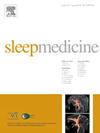社交时差和焦虑症状之间的联系:来自韩国工作人口的全国代表性样本的调查结果。
IF 3.8
2区 医学
Q1 CLINICAL NEUROLOGY
引用次数: 0
摘要
目的:社会时差(SJL)是由生物和社会节律失调引起的,与不良的健康结果有关。我们探讨了韩国工人的SJL与焦虑症状之间的关系。方法:本横断面研究纳入全国代表性样本,包括2731名成年工人。SJL计算为工作日和休息日睡眠开始和偏移时间中间点的绝对差值。使用广泛性焦虑障碍-7量表评估焦虑症状。采用Logistic回归估计比值比(ORs)和95%置信区间(ci)。结果:66.5%的人SJL为0 ~ 59 min, 22.6%的人SJL为60 ~ 119 min, 10.9%的人SJL≥120 min。焦虑症状在SJL 0-59分钟组中占3.4%,在SJL 60-119分钟组中占3.2%,在SJL≥120分钟组中占7.7%。与SJL时间为0-59分钟的工人相比,SJL≥120分钟的工人出现焦虑症状的几率增加(OR:2.04, 95% CI:1.10-3.78)。SJL每增加1小时,焦虑症状的几率增加1.35倍(95% CI:1.04-1.75)。在使用睡眠矫正公式调整睡眠剥夺的影响后,这种积极的联系仍然很强。结论:韩国工人SJL≥2 h与焦虑症状相关。需要采取政策措施,以减轻过度的SJL,并监测高SJL水平工人的心理健康。本文章由计算机程序翻译,如有差异,请以英文原文为准。
Association between social jetlag and anxiety symptoms: Findings from a nationally representative sample of the Korean working population
Objectives
Social jetlag (SJL), which arises from the misalignment of biological and social rhythms, is associated with adverse health outcomes. We explored the association between SJL and anxiety symptoms in Korean workers.
Methods
This cross-sectional study included a nationally representative sample, consisting of 2731 adult workers. SJL was calculated as the absolute difference in the midpoint between sleep onset and offset times on workdays and free days. The Generalized Anxiety Disorder-7 scale was used to assess anxiety symptoms. Logistic regressions were used to estimate the odds ratios (ORs) and 95 % confidence intervals (CIs).
Results
Among the sample, 66.5 % individuals had 0–59 min of SJL, 22.6 % had 60–119 min of SJL, and 10.9 % had ≥120 min of SJL. The prevalence of anxiety symptoms was 3.4 % for those with 0–59 min of SJL, 3.2 % for those with 60–119 min of SJL, and 7.7 % for those with ≥120 min of SJL. Workers with ≥120 min of SJL, compared with those with 0–59 min of SJL, were associated with an increase in the odds of having anxiety symptoms (OR:2.04, 95 % CI:1.10–3.78). A 1-h increase in SJL is associated with a 1.35-fold increase in the odds of anxiety symptoms (95 % CI:1.04–1.75). This positive association remained robust after adjusting for the effect of sleep deprivation using a sleep-corrected formula.
Conclusion
≥2 h of SJL is associated with anxiety symptoms in Korean workers. Policy measures are required to mitigate excess SJL and monitor the mental health of workers with high SJL levels.
求助全文
通过发布文献求助,成功后即可免费获取论文全文。
去求助
来源期刊

Sleep medicine
医学-临床神经学
CiteScore
8.40
自引率
6.20%
发文量
1060
审稿时长
49 days
期刊介绍:
Sleep Medicine aims to be a journal no one involved in clinical sleep medicine can do without.
A journal primarily focussing on the human aspects of sleep, integrating the various disciplines that are involved in sleep medicine: neurology, clinical neurophysiology, internal medicine (particularly pulmonology and cardiology), psychology, psychiatry, sleep technology, pediatrics, neurosurgery, otorhinolaryngology, and dentistry.
The journal publishes the following types of articles: Reviews (also intended as a way to bridge the gap between basic sleep research and clinical relevance); Original Research Articles; Full-length articles; Brief communications; Controversies; Case reports; Letters to the Editor; Journal search and commentaries; Book reviews; Meeting announcements; Listing of relevant organisations plus web sites.
 求助内容:
求助内容: 应助结果提醒方式:
应助结果提醒方式:


